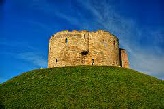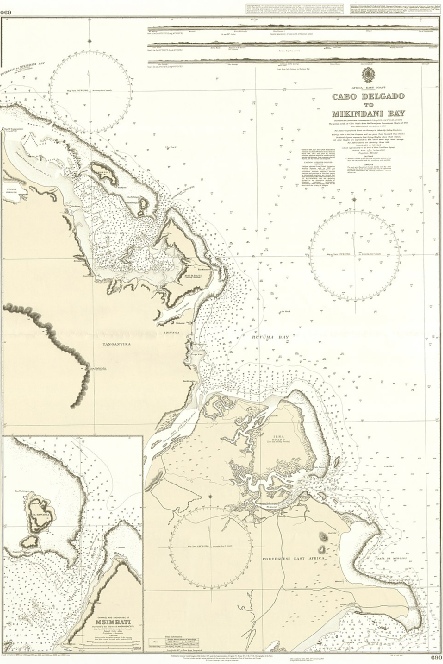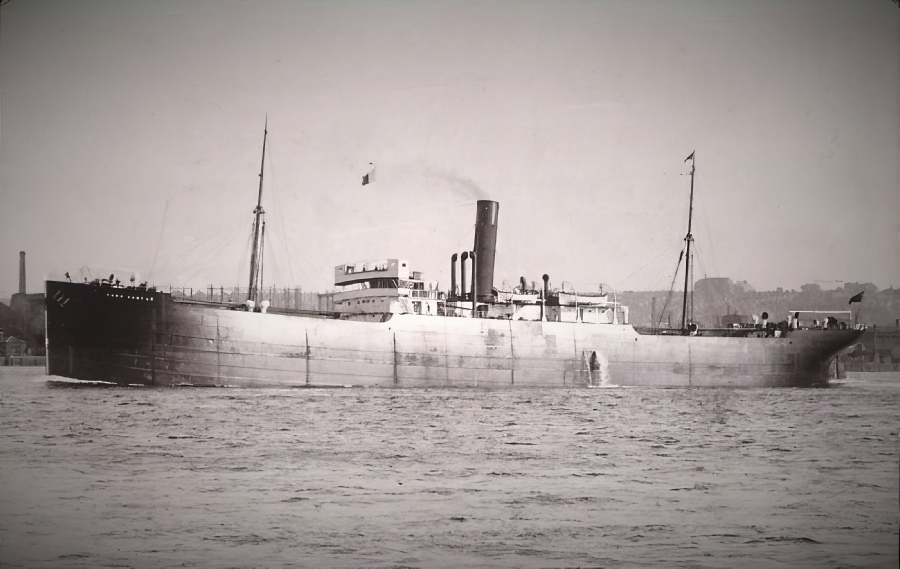YORK CASTLE was built in 1901 by Sir James Laing & Sons at Sunderland with a tonnage of 5517grt, a length of 408ft, a beam of 50ft 4in and a service speed of 12 knots.
She joined the cargo fleet in May 1901 and joined the three Union 'S' vessels on a triangular service between South Africa - USA - UK except during the fruit season when she traded between South Africa and the USA.
In 1924 she was sold to G. B. Bibolini of Genoa and renamed San Terenzo. After a short period laid up she was broken up during 1932.

|
Master
|
From
|
To
|
|
J T Robinson
|
5/1901
|
5/1903
|
|
E W Freeman
|
6/1903
|
1/1905
|
|
H M Cruise
|
3/1905
|
8/1908
|
|
E Mais
|
7/1908
|
7/1913
|
|
E J Holl
|
8/1913
|
4/1915
|
|
C R Jackson
|
6/1915
|
9/1917
|
|
G Owens
|
10/1917
|
11/1917
|
|
W A Swiney
|
11/1917
|
4/1918
|
|
C J Duncan
|
4/1918
|
11/1918
|
|
A Barron
|
4/1919
|
|
|
H B Rake
|
11/1919
|
|
|
G Sinclair
|
6/1920
|
7/1922
|
|
A O Morgan
|
1/1924
|
12/1924
|
Memories of York Castle in 1919 by Capt Jack Trayner
In 1919 I was appointed 3rd Officer of the York Castle, a cargo vessel of some 8,000 tons. Our cargo vessels were painted black and within the company were called “Black Ships” as opposed to the passenger vessels which had lavender coloured hulls. I had applied for a Black Ship in order to qualify for a Mate’s Certificate, which necessitated eighteen months seagoing service in charge of a watch. A 4th Officer does not take charge of a watch so that his seatime does not count.
We loaded a full general cargo for East and South Africa. The York Castle, although a strong and well built vessel, (the early steamships had hulls like sailing vessels, fine bows and counter sterns) she was old and slow, her average speed being something under 8 knots. All hands were excited on one occasion when the day’s run topped 200 miles but then someone remembered that we had put the clock back one hour during the night.
We went out through the Mediterranean and Suez Canal bunkering at Port Said ……
…... The Master, Capt Albert Barron, considered himself a very superior person. He sported an exagerated Oxford accent, was a devotee of Dornford Yates and mixed only with upper class people, he had no one to talk to on board York Castle as I once overheard him tell our Agent at Mombasa. We were all rather frightened of him. He yapped out orders like a drill sergeant and called me “Traynah!”
We discharged some cargo at Mombasa and loaded coffee and sisal. Many people had been in Kenya all through the war due to lack of passenger vessels. Our only spare cabin was booked so the Agent came aboard and told the Captain that an elderly married couple, (the man had recently suffered a stroke) badly wanted a passage to England. I was sent for and asked if I would let my cabin for £20 and double up with the 2nd Officer. This I did willingly and paid the 2nd £10 to share his cabin. I mention this to emphasise the desparate need people were in for transport in 1919, before the regular service of aircraft. Leaving Mombasa we proceeded down the East Coast of Africa.
One fine clear night, I was on watch, walking up and down the bridge, when, at about 9.30 pm, I saw a black line extending from four points on the starboard bow, right ahead, to a point on the port bow. I grabbed the glasses, it just looked blacker. There was no moon. I thought “Good God, it must be land”, and said “Hard a Starboard”. The helmsman put the wheel over and the ship payed off to port (Note - Helm orders were not altered until about 1931). I steadied her on East and called the Captain. He studied the horizon and agreed I had sighted land. He then set the course ESE bringing her two points towards the coast and went down to his cabin. I resumed walking up and down. The coastline was now clearly visible all along the starboard side.
Things seemed very quiet and, looking aft, I saw a lot of white broken water. Going to the wing of the bridge, I looked down and all was dark, no sign of movement. I rushed to the wheel, the helsman was dead on ESE. I threw the engine room telegraph to full astern, nipped down the bridge ladder, banged and opened the Captain’s door and said “We have run aground Sir”. He was out of his chair having heard the ER telegraph and immediately came on the bridge. We both peered over the side and saw the churning water coming along the ship’s side from aft. She was well and truly on the putty.
The Old Man, having temporarily lost his posh accent, shouted for all hands and worked the telegraph himself, ahead and astern, trying to wriggle her off the beach. He ordered us to take the lead line and sound round the ship. We found that she was well aground forward but the depth of water aft coincided with our draft, so she was just touching there. The 2nd Mate worked out the time of high water which was noon the next day so we had run on about two hours before high water. The carpenter sounded the bilges and reported all dry so she was not making water. The Chief Engineer reported sand coming in with the water intake so the skipper stopped the engines and sent all hands, except the watches, below.
At dawn we were all out, the Chief Officer ahd a boat lowered to which we lashed the kedge anchor. This was rowed out dead astern with two lengths of 6 inch hauling line attached. When the rope was tight the lashing was cut and the anchor dropped to the bottom. The Captain had ordered a full head of steam for 11 am, an hour before high water. The after peak was pumped out and a strain put on the kedge rope. The morning was fine and clear. The 2nd Officer had obtained a stellar observation and fixed the position at the mouth of the Roveena River about 15 miles north of Cape Delgado. Soon after 11 the Old Man started manoevring. He wriggled the hull by going ahead and astern for about half an hour, then gave orders to heave away on the kedge and full astern with a double ring on the engine. The propellor thrashed the water, churning it up into a boiling mass of foam but the ship remained fast. “Let go both anchors and pay out all the chain” roared the skipper. He was a sailor now, his social ambition forgotten. “Screw down the windlass brakes and all hands aft” he commanded. “Now roll ship” and all hands rushed to one side, stayed there for a few sonds before rushing across the deck to the other side. Almost high water and “She’s coming” cried the mate “we’re heaving in slack off the kedge” and so she did. Once started she slid off the beach and brought up all standing the two anchor chains leading right ahead. The kedge anchor was hove aboard to keep the propellor clear, as the old man hove in his anchors with the engine goi ng slow astern to drag the anchors through the sand. To pull the ship up to the anchors would risk getting ashore again on top of the tide. Whe we were quite clear the carpenter sounded the bilges again and reported all dry. The 2nd Officer and I had a drink that evening in the dog watch and agreed that the Old Man was a bloody good seaman in spite of his la de da manner.
We proceeded down the coast of East Africa, calling at Beira, Durban and Cape Town. At the latter port we transferred our passengers to a mail boat so I had my own cabin again. We also completed loading and sailed for the UK with a full cargo of East and South African produce: coffee, sisal, wool, hides, copper bars and cases of tinned fruit.
The voyage home was uneventful. The Company held an enquiry re our grounding on the East African coast, exonerating all from blame, recording the cause of the accident due to the ill lighted coast and an on shore current. The Captain, officers and crew were commened for their successful effort refloating the ship.
I made another voyage in the old “York” this time under the command of Captain George Sinclair. Whe we got to Durban we learnt that the Chief and 2nd Officers of Dundrum Castle had been landed into hospital with Typhoid Fever. The cause of the infection was found in the strainer of the saloon drinking water carafe. As the Dundrum Castle was due to sail, I was transferred to her as 2nd Officer and the mail boat in port provided us with a Chief Officer, one Perry Morgan. We were bound with a full cargo of Natal coal to Marseliies. Arriving there Captain Donald Graham was landed sick, the Chief Officer was promoted Captain and I Chief Officer. We took the ship to Middlebrough were we paid off.


|
Vessel
|
Built
|
Tonnage
|
Official No
|
Ship Builder
|
Engine Builder
|
Engine Type
|
HP
|
Screws
|
|
York Castle
|
1901
|
5310
|
112849
|
James Laing
Sunderland
|
Geo Clark
Sunderland
|
Triple Expansion Steam
|
2400 IHP
|
1
|
Career Summary








